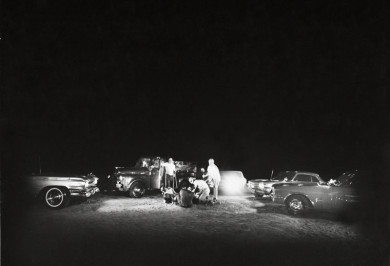Edward Kienholz
04 Sep 2011 - 15 Jan 2012

Edward Kienholz
Five Car Stud, 1969–72
Copyright Kienholz. Collection of Kawamura Memorial Museum of Art, Sakura, Japan. Courtesy of L.A. Louver, Venice, CA and The Pace Gallery, New York.
Five Car Stud, 1969–72
Copyright Kienholz. Collection of Kawamura Memorial Museum of Art, Sakura, Japan. Courtesy of L.A. Louver, Venice, CA and The Pace Gallery, New York.
EDWARD KIENHOLZ
Five Car Stud 1969–72, Revisited
4 September, 2011 – 15 January, 2012
Edward Kienholz’s Five Car Stud (1969–72) is a powerful work that depicts the hatred many white Americans expressed toward racial minorities and interracial partnerships in the not-too-distant-past; it stands as Kienholz’s major civil rights work. In this horrifying life-size tableau, four automobiles and a pickup truck are arranged on a dirt floor in a dark room with their headlights illuminating a shocking scene: a group of white men exacting their gruesome “punishment” on an African American man whom they have discovered drinking with a white woman. Commenting on the work and its theme of racial oppression, Kienholz said at the time, “If six to one is unfair odds in my tableau, then 170 million to 20 million is sure as hell unfair odds in my country.”
Although our society increasingly considers itself postracial, Five Car Stud is a harsh reminder of a shameful part of our history whose traces still linger. It was seen only in Germany in 1972 and has since remained in storage in Japan for almost forty years. This is its first public showing in the United States.
Five Car Stud 1969–72, Revisited
4 September, 2011 – 15 January, 2012
Edward Kienholz’s Five Car Stud (1969–72) is a powerful work that depicts the hatred many white Americans expressed toward racial minorities and interracial partnerships in the not-too-distant-past; it stands as Kienholz’s major civil rights work. In this horrifying life-size tableau, four automobiles and a pickup truck are arranged on a dirt floor in a dark room with their headlights illuminating a shocking scene: a group of white men exacting their gruesome “punishment” on an African American man whom they have discovered drinking with a white woman. Commenting on the work and its theme of racial oppression, Kienholz said at the time, “If six to one is unfair odds in my tableau, then 170 million to 20 million is sure as hell unfair odds in my country.”
Although our society increasingly considers itself postracial, Five Car Stud is a harsh reminder of a shameful part of our history whose traces still linger. It was seen only in Germany in 1972 and has since remained in storage in Japan for almost forty years. This is its first public showing in the United States.
